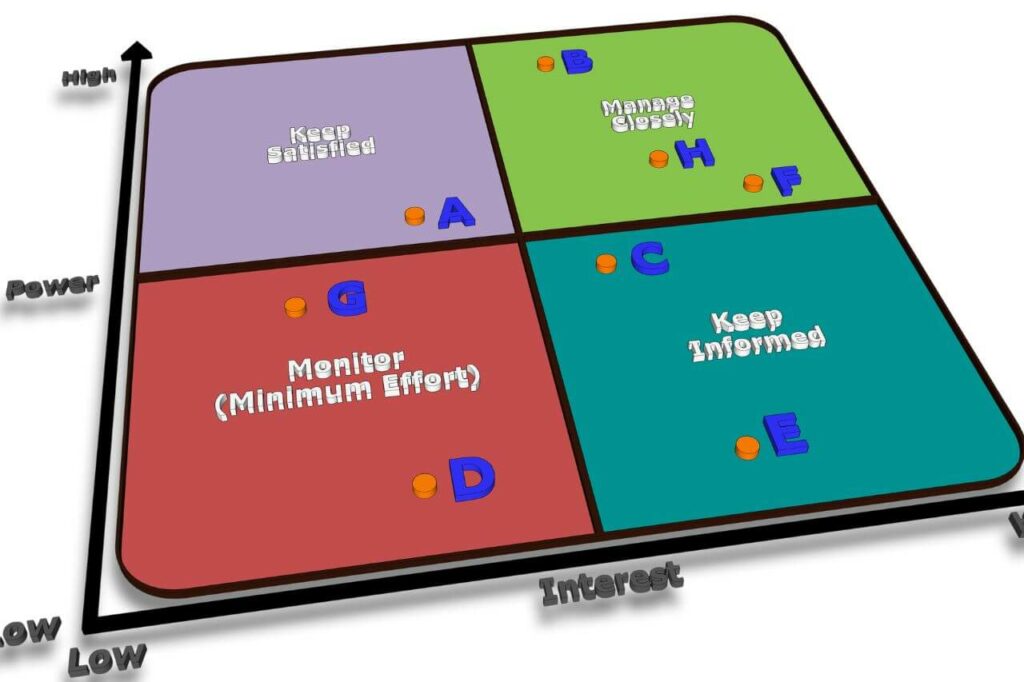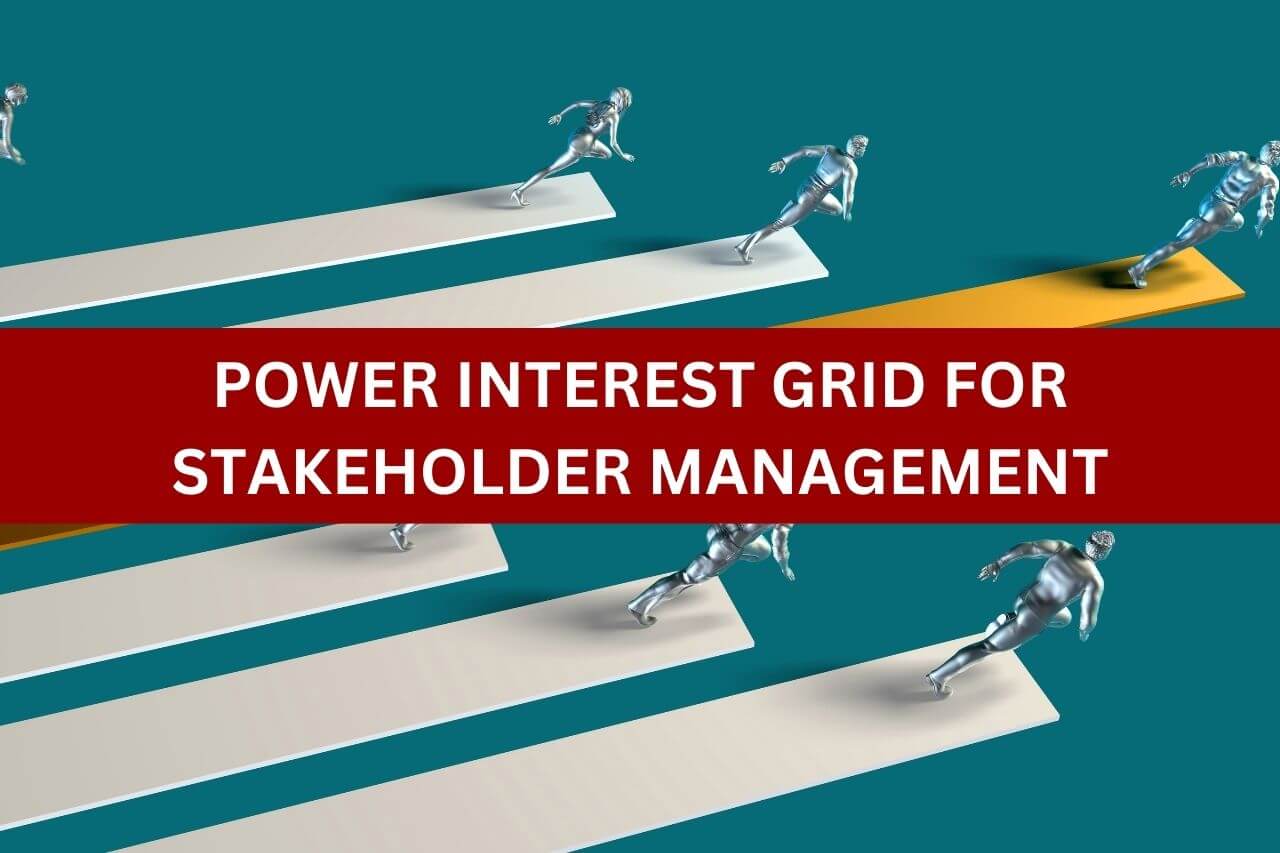The struggle to manage stakeholders on your project and keep everyone happy can be a real headache, especially when there are conflicting interests at play. That’s where the power interest grid comes in handy.
This simple yet powerful tool helps you visualize the relationships between stakeholders and understand where their priorities lie.
By plotting each stakeholder on a grid based on their level of power and level of interest in the project, you can start to see patterns emerge and figure out the best way to manage those relationships.
In this blog post, we’ll explore the power interest grid in detail and show you how to use it to improve your stakeholder management strategy.
We’ll also provide some tips and best practices for making the most of this tool. So whether you’re a seasoned project manager or just starting out, this post is for you.
Project Stakeholder Management
Stakeholder management is key to the success of any project. It’s all about keeping the people who are invested in your project – whether they be customers, employees, or shareholders – in the loop and making sure their needs and expectations are being met.
Proper project management requires identifying all project stakeholders, analyzing their power, interest, influence, and impact, eliciting their requirements and expectations, and incorporating all these into the product and project scope.
During the entire project life cycle, stakeholder management must be done, and stakeholders must be involved in the project at the necessary levels for project success.
The first step to take to manage your project stakeholders is to identify who the stakeholders actually are. This should be done as early as possible as stakeholders that are identified late will bring their own requirements and expectations which can affect the project constraints.
After identifying the stakeholders, you need to determine their requirements and expectations. These requirements should be evaluated and prioritized, and expectations clarified to keep everyone on board.
Next, you need to do a stakeholder analysis to determine their power, interest, and influence. With this analysis, you can plan how to engage, manage, and communicate with stakeholders throughout the project.
Overall, stakeholder management is all about communication and being proactive. By staying in touch with the people who are invested in your project and being open and transparent about what’s going on, you’ll be well on your way to keeping everyone happy and ensuring your project’s success.

What is a Power Interest Grid (Mendelow Matrix)
A power interest grid also known as a Mendelow Matrix is a tool used in project stakeholder management to analyze the relationships between stakeholders and understand their power and interest in a project.
It’s a graphical representation that helps project managers understand the potential impact of each stakeholder on the project. The grid plots stakeholders on a grid with two axes: power and interest.
The power axis shows a stakeholder’s ability to influence the project, and the interest axis represents their level of involvement or commitment.
Stakeholders with high power and high interest are the most important and should be given special attention. Those with low power and low interest are the least important.
Stakeholders with high power and low interest or low power and high interest may also need special attention depending on their characteristics and impact on the project.
The power interest grid helps project managers identify and prioritize stakeholders and develop strategies for effectively engaging and managing them throughout the project.
Read Also: 5 Project Cost Management Best Practices

Benefits of Using a Power Interest Grid for Stakeholder Management
The power interest grid is a valuable tool for project managers to better understand the stakeholder landscape and develop effective strategies for engaging and managing stakeholders throughout the project.
Using a power interest grid in project stakeholder management has a ton of benefits. Some of these benefits include:
1. Identification and Prioritization of Stakeholders
By plotting stakeholders on the grid, you can quickly see which stakeholders are the most influential and have the most at stake in your project.
This allows you to focus your time and energy on engaging and managing these key stakeholders effectively.
2. Understanding Stakeholder Motivations
By using a power interest grid, you can have a better understanding as a project manager of why each stakeholder is interested in the project, and how their power and influence may affect the project’s success.
This can be especially useful for managing stakeholders with high power and low interest, or low power and high interest.
3. Development of Effective Stakeholder Engagement Strategies
By understanding the power and interest of each stakeholder, you can tailor your communication and engagement strategies to effectively address the needs and concerns of each stakeholder group.
4. Anticipation and Management of Stakeholder Conflict
By identifying stakeholders with conflicting interests and power dynamics, you can proactively address potential conflicts in your project and work to resolve them before they become major issues.
Read Also: 8 Great Ways To Inspire Your Agile Team For Top Productivity

How to Create and Use a Power Interest Grid
To create and use a power grid for stakeholder engagement and management, you can use the following steps:
1. Identify the Project Stakeholders
The first step in creating and using a power interest grid is to identify all of the stakeholders in your project. This may include internal stakeholders (such as employees and department managers) and external stakeholders (such as customers, suppliers, and regulatory agencies).
2. Determine the Power and Interest of each Stakeholder
Next, determine the power and interest of each stakeholder. To assess power, consider the stakeholder’s ability to influence the project, including their authority, resources, and expertise.
To assess interest, consider the stakeholder’s level of involvement or commitment to the project, and how it may be impacted by the project’s outcomes.
This way, there are 4 categories of stakeholders:
- High power and high interest
- High power and low interest
- Low power and high interest
- Low power and low interest
3. Create the Grid
Using a spreadsheet or other visual representation, create a grid with two axes: power and interest.
4. Plot Stakeholders on the Grid
Once you have determined the power and interest of each stakeholder, plot them on the grid using a visual representation, such as a scatterplot or a matrix.
You can put them into 4 boxes created on the grid this way:
- Top right: Stakeholders with high power and high interest.
- Top left: Stakeholders with high power and low interest.
- Bottom right: Stakeholders with low power and high interest.
- Bottom left: Stakeholders with low power and low interest.
5. Identify and Prioritize Stakeholders
Review the power interest grid and identify which stakeholders are the most influential and have the most at stake in the project (those with high power and high interest).
These stakeholders should be given the most attention and resources by the project manager.
6. Develop Stakeholder Engagement Strategies
Based on the power interest grid, develop strategies for engaging and managing each stakeholder group effectively.
This may involve different communication tactics, such as regular updates or one-on-one meetings, depending on the needs and interests of each stakeholder group.
7. Monitor and Review the Grid Regularly
As the project progresses, monitor and review the power interest grid to ensure that your stakeholder engagement strategies are effective and that you are addressing the needs and concerns of all stakeholders.
Be prepared to make adjustments to your strategies as needed to ensure the success of the project.
Read Also: Is Agile the Right Fit for Your Organization?

Managing Stakeholders with Power Interest Grid
The strategies for managing stakeholders in each quadrant of the power/interest grid will depend on the specific needs and goals of your organization.
It’s important to be flexible and adapt your approach to each individual stakeholder, as their power and interest may change over time.
However, here are some general strategies that may be helpful to consider:
Quadrant 1 (High Power/High Interest) – Manage closely
Stakeholders in this quadrant (such as shareholders or regulators) are likely to have a significant impact on your organization and are highly interested in what you do. They are to be managed closely.
It’s important to be proactive in engaging with these stakeholders and to establish regular, formal communication channels.
This may involve holding regular meetings or presentations, providing timely updates and information, and being responsive to their needs and concerns.
Quadrant 2 (High Power/Low Interest) – Keep Satisfied
These stakeholders (such as key suppliers or major customers) have the ability to influence your organization, but may not be as directly involved in your operations.
It may be effective to engage with these stakeholders on an as-needed basis, using targeted communication and outreach to address specific issues or concerns.
Quadrant 3 (Low Power/High Interest) – Keep Informed
Stakeholders in this quadrant (such as community groups or advocacy organizations) may not have as much direct influence on your organization, but they may have a strong interest in what you do.
It’s important to be transparent and responsive to these stakeholders, and to consider their needs and concerns in your decision-making process.
This may involve providing regular updates and information, engaging in dialogue, and seeking feedback and input.
Quadrant 4 (Low Power/Low Interest) – Monitor
These stakeholders (such as casual customers or employees with minimal influence) may not have much impact on your organization and may not be as directly involved in your operations.
It may be sufficient to provide occasional updates and information to these stakeholders, and to be responsive to their needs if and when they arise.

Power Interest Grid Templates
If you require PowerPoint Templates for a power interest grid that are editable, compatible with Google slides and Keynote, and completely free, Slidemodel has you covered on that.
Conclusion
The power/interest grid is a useful tool for organizations looking to effectively manage their stakeholders.
By identifying and categorizing stakeholders based on their level of power and interest, organizations can develop targeted strategies for engagement and communication.
It’s important to remember that every stakeholder is unique, and a one-size-fits-all approach is unlikely to be effective.
Instead, organizations should be flexible and adapt their approach to each individual stakeholder, taking into account their changing needs and concerns.
Ultimately, effective stakeholder management is key to building strong relationships and achieving success.





